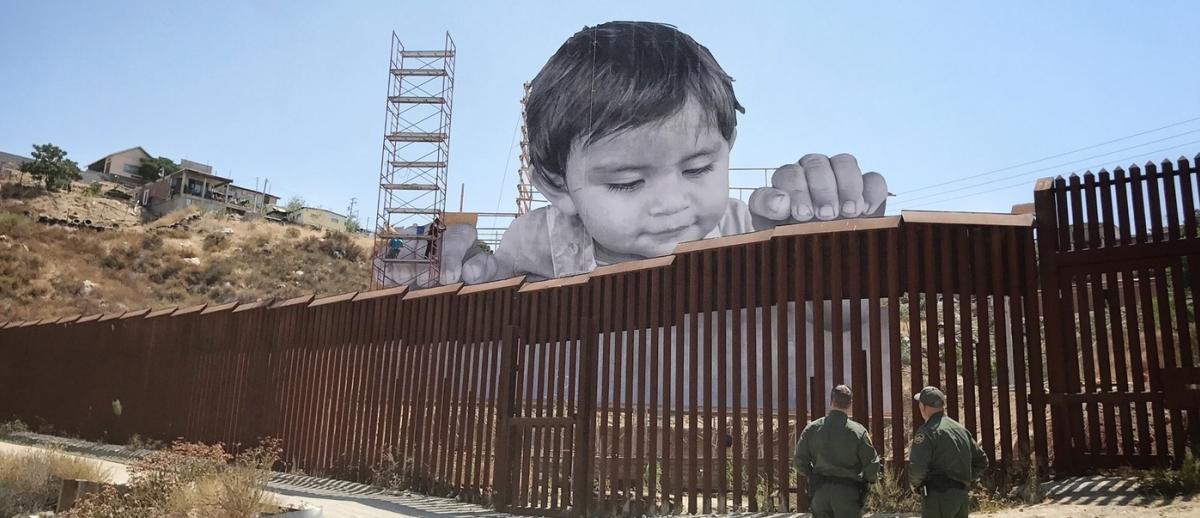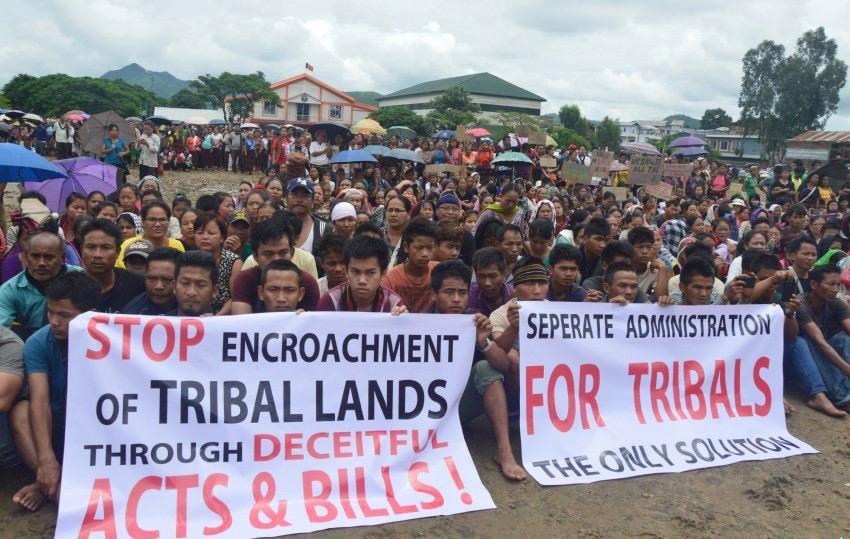Human vs. National Security
archive


installation by French artist JR peers over the U.S.-Mexico border at Tecate, California. Source: Guillermo Arias/AFP/Getty Images
Human vs. National Security
What comes first Human or National Security? This has been an enlivening yet never ending debate. In the case of national security, threats are mainly perceived as external challenges to a nation’s sovereignty, which in turn is largely based on the integrity of its geographical whole. The state is a referent and determining object in national security, an impregnable fortress. Therefore, national security becomes too sensitive an issue. It overwhelms and marginalizes all other critical human-centric securities including food, environmental, and energy. In fact, it is often used to justify all that which brings conflict, violence, dislocation and underdevelopment.
On the other hand, advocates of human security vehemently confront the orthodox account of security. They question its adequacy in understanding and assessing the actual nature and scale of threats to human beings. From a human security perspective, human beings are the primary referents, not the state. This challenge became much more resounding after the end of the cold war with the changing nature of threats and instabilities among human populations.
Human security advocates now highlight the complexities of sources of insecurity among human populations in various situations and locations. They respond to crucial queries like ‘what makes people feel secure?’ in a much more convincing manner. The basics of human security are primarily ensured by meeting common aspirations that people cherish most. These include food for the family, adequate shelter, good health, schooling for the children, protection from violence, and freedom from pervasive threats to people’s rights and safety—their ability, that is, to live a life free of fear. They argue that these non-traditional security parameters actually determine the state of human and then national security. However, in this situation the state-society relationship is separated from ‘international relations’, and the domestic realm becomes more exclusive to human security.
South Asia has been a theater of major security concerns and vulnerabilities at regional, federal, and local levels. The nature and content of these insecurities are diverse and mostly relate to non-traditional paradigms. They include political demands pursued through terrorism and insurgency; forced and voluntary migration resulting from socio-political conflicts; environmental displacement caused by natural disasters and development projects; as well as poverty, starvation, and farmer suicides. At the heart of these security concerns are livelihood and nutritional concerns, decreasing access to public utilities, human rights violations, skewed distribution of natural resources, harmful development and technological interventions, natural disasters, inimical production structures and market-based reforms. These are not at all recognized in the orthodox framework of security.
South Asian strategic thinkers have always sidelined and trampled any attempt to change the traditional contours of security discourse that would bring human aspects to the forefront. This is attributed to the very nature of post-colonial state formation, strategic and military alliances, and territoriality-based diplomatic engagements. All these have oriented national security issues more to external parameters, and ignored internal dynamics. In the process, citizens’ insecurity has often been neglected, sacrificed by the state in the name of larger military security interests. Thus human security as an internal agenda and military security as a national agenda subject themselves to two distinct treatments by the same state.
Human security advocates…argue that non-traditional security parameters actually determine the state of human and then national security.
Since these ‘other threats’ to security do not impinge upon sovereignty directly, they have tended to be treated as problems of nation building that involve socio-political contingencies and development dynamics. They were consciously kept out of any national security debates or agendas.
For instance, despite hunger deaths, suicides by farmers, and conflicts triggered by deprivations, the larger question of food security and protection of borders and boundaries for sovereignty could never be linked. Could this mean that food provisioning can be neglected, but not the national borders? Here the most fundamental question is: for whose security are the national borders to be protected? Where do individual and community insecurity and national insecurity meet? The simmering tension persists.

Manipur, India: sit-in protest in Churachandpur district, September 2015
Nevertheless, there have been conscious attempts by scholars, institutions, civil society organs, and even by some governmental agencies across India to ‘import’ and link the emerging international discourse on the changing contours of security to the complex realities in South Asia. Consequently, the overarching matrices of security are fast changing. The notion of nationalism based on territoriality is diminishing. Security has assumed wider connotations going beyond borders. The uniformity and singleness that seemingly prevail in the perception and handling of borders at the national level are now steadily diluted and blunted. Local and micro understanding, and multi-faceted interactions in the border areas, are becoming vital. Security dimensions are becoming more local than national.
Demystifying Linkages
In some situations, these human insecurities have resulted in protracted violence, insurgencies, and terrorism, and attracted cross border sympathies and affiliations. This in turn has injected threats into both ‘internal’ and ‘national’ security. There are instances galore, ranging from the Kuki-Naga clashes in Manipur to the Khalistan Movement of 1980s and to LTTE (Liberation Tigers of Tamil Eelam, more commonly the Tamil Tigers) clashes with the Army in northeastern provinces of Sri Lanka that ended in 2009. In India, over 160 districts of 13 States have been affected by Naxalite influence and violence making it the “single biggest internal security challenge.” This also means that under a particular situation of human insecurity “our own people” become a threat to “internal security” and “national security.” However, here also a ‘human security dimension’ is distinguished from ‘national security’ by the State.
Another example is the communal riots of Gujarat in 2002 and the Kargil war fought against Pakistani forces in 1999. Both these incidents killed and displaced a large number of people, destroyed property, and caused huge losses to the exchequer. Both created serious human insecurity. Yet the treatment by the state was distinctly different and discriminatory. The central security forces including the army were used in both situations, and both had the potential to conflagrate into major national security crises. Both were covered extensively by the media and widely discussed in Parliament. In fact, the former nearly toppled the then National Democratic Alliance government.
...the overarching matrices of security are fast changing. The notion of nationalism based on territoriality is diminishing. Security has assumed wider connotations going beyond borders.
Despite these striking similarities, the Gujarat riots remained an ‘internal security’ concern, popularly called a “law and order” problem, while the Kargil war was considered a ‘national security’ problem. Is it because the first took place essentially within the country and the second, had a major external dimension? Or is it because the first was more geographically localized and the second had a national appeal? In fact, both were localized problems with potential for further spread and conflagration. Both had strong national appeal. The Kargil war also had a high content of human insecurity, which was possibly overshadowed by the “externality” and “national security” concerns. Could it be a problem of political denial and power-risk to declare an internal human security-related problem as a national security problem?
Similarly, why are extreme left violence and conflicts like those stirred by the Maoist movement an internal law and order problem, and at the same time, insurgencies in the North East region (like those in Mizoram, Nagaland, and Manipur) were and have been considered to be in the ambit of national security, not law and order? Had the Maoists in Nepal during their violent activity there between 1996 and 2006 joined their counterparts across the open border in India, would that have transformed the Maoist problem from being one of internal to national security? The former is a non-traditional and the latter a traditional security threat. What stops us from recognizing the former also as a national security threat?
What is the distance between ‘internal’ and ‘national’ here? Where is the meeting point? They have all the elements of convergence, yet in the State’s thinking they are hardly related. What makes these two concepts deviate? Are there any substantive factors that keep the two concepts mutually exclusive and tightly compartmentalized? Or is it only a difference of perception, based on a mindset? Or, a conscious state policy to treat some as national security and others as internal security issues because of the federal structure, democratic polity, and colonial practices? The answer to these questions lies with a resolution to the inexplicable issues and paradoxes of orthodox vs. non-orthodox security. This solution could also, perhaps, begin to unwind the monopolization and domino effect of orthodox security thinking over human security discourse.



